















Transport back to all things old Hollywood… Enjoy conversation with one another over one of our craft cocktails & small bite offerings.
Enjoy lively music, fine cocktails, food offerings galore, and the company of one another at Falcon’s Lair - Ripon’s newest restaurant/lounge with an old Hollywood flair.
HOURS: TUESDAY - THURSDAY 4PM - 9PM • FRIDAY AND SATURDAY 4PM - 10PM • CLOSED SUNDAY & MONDAY 1225 CANAL



For the you taking care of your heart, and theirs. We deliver proactive preventive care that’s proven to keep you healthy, and world-class treatment if you do get sick. Choose Kaiser Permanente, and get high-quality, personalized care, designed to help you spend more healthy years doing more of what you love. Learn more at kp.org/centralvalley
For all that is Central Valley. For all that is you.






















Berries — whether piled high on a stack of pancakes, thrown into a spring salad or enjoyed just-picked from your backyard garden — are one of best things about springtime in the 209. In this issue, we feature two local you-pick berry farms, as well as tips for growing and preserving your own berries.

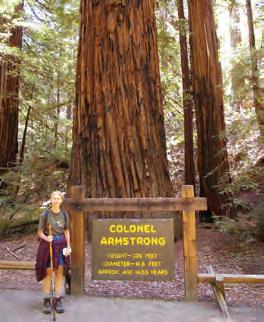


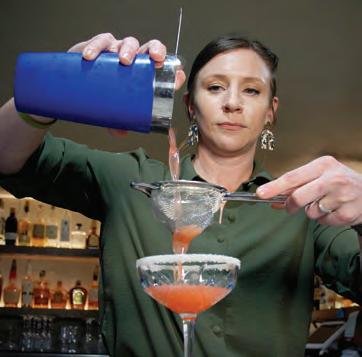

PUBLISHER/OWNER
Hank Vander Veen
MANAGING EDITOR
Sabra Stafford
EDITOR
Kristina Hacker
WRITERS & PHOTOGRAHERS
Chris Correa
Joe Cortez
Kristina Hacker
Teresa Hammond
Marg Jackson
Matt Johanson
Claudia Newcorn
Vince Rembulat
Sabra Stafford
Frankie Tovar
CREATIVE DIRECTOR
Harold L. George
ARDVERTISING
Chris Castro
Beth Flanagan
Rich Matheson
Karen Olsen
Corey Rogers
Melody Wann
Charles Webber


Welcome to the spring edition of 209 Magazine. There are a lot of things to celebrate in spring — green rolling hills, blooming wildflowers and the perfect weather for outdoor activities. Another great thing about spring are all the berries that are ready for picking. In this issue, we feature local you-pick berry farms, as well as tips for growing your own berries.
In our Hey Bartender feature, Karisa McCuistion shares the secret of her must-try Berry Good Martini, the perfect drink the celebrate the fruit of the season.
Another locally grown produce that is ripe in spring is asparagus and at the Stockton Asparagus Festival you can sample and celebrate all things asparagus. For more details about the festival, look on page 16.
Spring is also a good time to get out and enjoy an art exhibit or play. Sierra Repertory Theatre is presenting sci-fi classic “Little Shop of Horrors” at the Fallon House Theatre in Columbia State Historic Park through the end of April. Starting May 9, Sierra Rep’s East Sonora Theatre will present “The Drowsy Chaperone,” a Golden Age musical.
SCAN this to advertise in 209 Magazine or call Manteca • (209) 249-3500 • Newman • (209) 243-8170 Oakdale • (209) 847-3021 • Turlock • (209) 634-9141 209 Magazine is published 6 times a year

209 Magazine is a product of
121 S. Center St., 2nd Floor • Turlock, CA 95380 Comments: sstafford@209magazine.com 209magazine.com
The Tuolumne County Museum will present a new exhibition that highlights California’s Mexican period, which lasted from 1822-1846, and holds them up alongside the fantasy depictions used by early stakeholders. “Telling Stories of Mexican California: Real Life & Myth Making” opens April 7 and runs through June 2.
Climbing Yosemite’s ‘Little Big Wall,’ aerial arts classes at The Fix and clover lawns are also featured inside this issue of 209 Magazine.
We at 209 Magazine appreciate your time in reading this issue. We welcome your comments, calendar events and stories. We hope you will support the businesses and charities that have chosen to partner with us. We appreciate them and look forward to being the most relevant magazine in your home, a place called 209.
Hank Vander Veen Publisher & Owner hvanderveen@209magazine.com






There’s been a buzz of activity in the 209 region and 209 Magazine was on hand for the fun. To have your organization featured in Scene in the 209, email sstafford@turlockjournal.com.
Gatherings and events may have been thrown a curve ball over the last couple months, but 209 residents are resilient and found safe ways to come together and enjoy the holiday season and start the new year.
Stockton played host to a well-attended pop-culture convention on Feb. 24 and 25, at the Stockton Arena. Attendees, most of whom came dressed as their favorite characters, were able to check out the numerous comics, games, action figures and toys, video and card games and more.



Spider-Woman (Erika Chero of San Pablo) poses with 49erthemed Thor (Monica Lopes of Hercules) and Wolverine (Erik Lopez of Hercules) in an unexpected Marvel crossover.


BREAKFAST AT TIFFANY’S
Intermission in Modesto invited guests to wear their best little black dress and pearls for a showing of the classic film “Breakfast at Tiffany’s” starring Audrey Hepburn and George Peppard on Feb. 26.

“EMPOWERING STORIES: CELEBRATING WOMYN’S VOICES”
UC Merced brought Natalie Baszile, the author of “Queen Sugar” and “We Are Each Other’s Harvest” and Brenae Royal, a trailblazing Sonoma winemaker and an Atwater native, to town for a celebration of “Womyn’s Herstory Month.” The event not only highlighted the accomplishments of the two women, but also their connection to agriculture, food and wine.




Natalie Baszile,
UC Merced Executive
Chef Mitch Vanagten, Brenae Royal and American Culinary Federation Monterey Bay Chapter Executive Chef Jacques Wilson.
5 2024 APR 2024 APR 12 2024
The Big Bounce America 2024 tour is bringing the bounciest experience of the year to Stockton from April 5 through April 7, at the San Joaquin County Fairgrounds.
Featuring The World’s Largest Bounce House, The Big Bounce America is the biggest touring inflatable event in the world and includes eight massive inflatable attractions: the newly expanded 24,000 sq. ft. World’s Largest Bounce House; the brand-new deep sea foam party inflatable OctoBlast; the incredible 900+ ft. long obstacle course The Giant; the customized sports arena Sport Slam; and the unique, threepiece, space-themed wonderland airSPACE.
All-Access Tickets are available online. These tickets include a three-hour pass to the event, including a timed session on The World’s Largest Bounce House, as well as unlimited access to OctoBlast, Sport Slam, The Giant, and airspace. Tickets start at just $22. For tickets and pricing, go to thebigbounceamerica. com/tour-dates.
In celebration of artistic origins, Playhouse Merced will present We Are Merced, a showcase featuring music and dances performed by cultural heritage keepers residing in the community.
We Are Merced is a free admission community event, funded by the California Creative Corp.’s Heartland Grant.
This celebration of cultural artistry will take place at 7:30 p.m. on April at the historic Art Kamangar Center at The Merced Theater. Tickets are available at WeAreMerced. com and are on a first come, first serve basis. For more information about We Are Merced and other upcoming events, please visit the website at www. playhousemerced.com or contact the Box Office at 209-725-8587.

The Modesto Symphony Orchestra presents Mendelssohn’s Violin Concerto on April 12 and 13, led by Music Director Nicholas Hersh. The weekend’s concerts will feature the MSO’s debut of the works of Argentinian-composer Astor Piazzolla’s Tangazo (Variations on Buenos Aires), and French-composer Louise Farrenc’s Symphony No. 3 in G minor. The program also includes an arrangement by Hersh of Johann Sebastian Bach’s Fugue in G minor, also known as the “Little Fugue.” The concert will conclude with Felix Mendelssohn’s Violin Concerto in E minor, featuring world-renowned violinist, Tai Murray as the soloist.
“The centerpiece of this concert is Mendelssohn’s Violin Concerto, a masterful blending of virtuoso violin technique and enchanting musical beauty,” says Music Director Nicholas Hersh. “From the soaring melody of its first movement to the effervescent gallop of the finale, there isn’t a moment that won’t captivate and delight our Gallo Center audiences. With violinist Tai Murray bringing her indefatigable energy to the concerto, too, this is truly a musical event not to be missed.”
The concerts will be performed at the Gallo Center for the Arts in Modesto.
Tickets range from $20 to $94, along with $12 tickets for students. Tickets are available online through ModestoSymphony.org or through the Gallo Center for the Arts Ticket Office at (209) 338-2100.
APR 13 2024 MAY18 2024 JUN 1 2024
The Fourth Annual Tuolumne County Art Week will be April 13-21.
The week will celebrate creative excellence with the 37th Annual InFocus Competition, Exhibition and Sale, the 69th Annual Mother Lode Art Association Juried Fine Art Show and Exhibit, and more than a dozen special artist showcases and offers throughout the county.
The 37th Annual InFocus Competition, Exhibition and Sale will take place April 7-21, at the Jamestown Community Hall. The juried show draws more than 50 amateur and professional photographers, competing in the subject categories of nighttime, landscape, manmade, people, plants, and animals.
The 69th Annual Mother Lode Art Association Juried Fine Art Show and Exhibition will showcase local and regional artists› works from April 12-20, at the Sonora Opera Hall. A silent auction and raffle will be held during the show. Artists’ work for sale can be purchased, with part of the proceeds going to support art in Tuolumne schools.
In addition to the juried art shows, there will be more than a dozen special showcases and offers featuring local artists and craftspeople. Visit Tuolumne County provides a list of participants and activities at www.visittuolumne.com/ art-week.
Tuolumne County Art Week is held in conjunction with California Arts, Culture & Creativity Month, an annual awareness and advocacy event that recognizes the role of arts, culture, and creativity in the lives of Californians.
The City of Livingston Parks Recreation and Arts Commission in collaboration with the Merced County Indian Chamber of Commerce will present the 4th annual Livingston Splash of Color Run 5k Fun Run on May 18.
This run directs its participant to run through showers of colored powder at six different color stops throughout the race course. With the Merced County Indian Chambers partnership they will bring a “Holi” color activity to Arakelian Park in the middle of the run.
This untimed family oriented event will be held in Livingston and is expected to attract over 1,000 participants of all ages. The race will be held May 18. Check in is at 9 a.m. at Memorial Park, 1339 Main St., Livingston and the race will start at 10 a.m. after the check-in party and color blast!
This event has attracted numerous sponsors. Because of the generous sponsorships the race entry fee is only $35 for adults and $25 for kids in advance. This includes the entry fee, a Color kit an event T-shirt and an extra color packet and water. There is also a no frills only entry that includes race ticket and color. Pre-registration is required for the color kit and can be done at City Hall, 1416 C Street in Livingston or online at www.runsignup.com. Registration deadline is 4:30 p.m. on April 15. Call 209-394-8830 for more information.
The Manteca Chamber of Commerce will host the Watermelon Street Fair from 10 a.m. to 5 p.m. June 1 and 2 in downtown Manteca. The event will feature more than 40 food vendors, craft and commercial vendors, a beer garden, live music, a car show, kid activities and other attractions.
For more information visit Manteca.org/ watermelonstreetfair.

JUN 8 2024
The extravagant, lauded and inimitable Menagerie Oddities Market, whose credo is, “This Ain’t Yer Grannies Craft Fair” returns to Amador County’s Preston Castle in Ione from 11 a.m. to 6 p.m. on June 8.
On display will be 50 artisans, creators, and purveyors of strange and unusual craftings, baubles, trinkets, ornaments, novelties, knickknacks, ephemera, elegant jewelry, clothing, accessories, medical and scientific specimens, antiques, photography, home decor, taxidermy, works of fine art, and other collectible oddities and curiosities created from components, parts, pieces,
bugs, bones, items and elements handmade, foraged and found.
General admission includes live entertainment, interactive presentations and poison exhibits by Dr. R. Snick, performances from Stilt Boy, the many faces of Gus. and the Renegade Circus, tarot card readings, face painting and carnival games for the kids, ice cream, food trucks, full bars, and music. Guests can also add a self-guided tour of the famous Preston Castle, and a butterfly or moth pinning workshop.
Under 5 years of age get in free. There will be free parking with roundtrip shuttle service.













For nearly four decades, the Asparagus Festival has served as a celebration to promote the area’s popular spring vegetable.
In the course of that time, the popular Asparagus Alley have dished out more than 10 tons of California-grown asparagus served up in a variety of ways.
The Noceti Group – led by entrepreneur Tony Noceti, a French Camp farmer and auto racer – has kept the event in Stockton, giving back more than $750,000 to non-profits since 2015.
The 38th annual San Joaquin Asparagus Festival is a threeday celebration featuring an array of asparagus-related dishes coupled with carnival rides and games, live music, chef demonstrations, and even Monster Truck rides.
All this and more will once again take place at the San Joaquin County Fairgrounds at 1658 S. Airport Way on the weekend of April 12-14.
“Every year we have several more asparagus-related dishes to our already outstanding deep-fried asparagus and asparagus ice cream, such as dishes that have made their debut at the festival, present and past,” according to festival organizers.
This includes, but not limited to: bacon-wrapped asparagus, asparagus lumpia, pulled pork sandwich served on asparagus slaw, asparagus chicken bowl, asparagus corn dogs, asparagus chili cheese fries, asparagus nachos, chicken asparagus burrito, steak asparagus burrito, veggie asparagus burrito, asparagus pasta, deep-fried ground beef & asparagus wrap, steamed asparagus with garlic butter, crab & asparagus balls, asparagus churros, asparagus rice & Lo Mein, and mac & cheese with asparagus, to name a few.
The festival made its debut in 1986 as way to promote the area’s fresh market asparagus.
The inaugural event was held at Oak Grove Regional Park in Stockton – its home for several years before moving to downtown and later to the fairgrounds – and was created by the local economic

The San Joaquin Asparagus Festival Scholarship Pageant will crown the next Teen, Miss, and Ms. Included are the 2023 reigning Ms. Erin Hagerty, Teen Miss Morgan Williamson, and Miss Caydence Rodriguez.
development committee under the supervision of the City of Stockton.
The Stockton Art Commission, a division of the city, oversaw the event through 2015 – this division of the city was able to do it thanks to a local endowment fund.
Here’s a few of the highlights for 2024 San Joaquin Asparagus Festival:
Gastronomic Extravaganza – A culinary adventure with an array of asparagus-themed dishes. Foodies can explore the various options of this beloved vegetable.
Live Entertainment – A lineup of local bands and nationally acclaimed artists. The festival stag will kick it with sounds of diverse genres for every musical taste.
Family-Friendly Activities – From carnival rides and games to interactive exhibits, the festival’s Kids Zone features activities for children of all ages.
Asparagus Marketplace – This is where festivalgoers can discover unique and locally crafted items by artisans and vendors, from handmade crafts to specialty goods.
Educational Exhibits – Learn about

the rich agricultural history of the San Joaquin Valley while gaining insights into the asparagus farming process and its significant role in shaping the region.
Community Spirit – The San Joaquin Asparagus Festival is not just an event but a chance for those in attendance to celebrate its agricultural heritage along with the pride and unity that define the city.
For more information, log on to www. sanjoaquinasparagusfestival.net ●
t 14 years old, Chris Murphy was just the right age when “Star Wars” debuted in theaters 47 years ago. He was young enough to be mesmerized by the groundbreaking special effects and the galactic array of characters, but old to enough to understand the the movie’s themes of betrayal, revenge, and rebellion. Oh, and most importantly, the concept of light speed. That was crucial.
“There was a Modesto Bee photo of opening day at the Briggsmore (theater),” recalled Murphy. “Terry Allen, whose parents owned Bonanza Books, and Dave Ackerman, and I were the first three in line for that original premiere showing.”
Raised in Modesto, the hometown of “Star Wars” creator George Lucas, Murphy has always felt a special connection to the franchise.
“It’s just amazing to think that we own this,” said Murphy. “I’ll go to Disneyland and walk through Star Wars: Galaxy’s Edge and just feel superior. George Lucas cooked up something that consumed Disneyland. Our guy ate Disney.”
And somewhere along the way, May the Fourth — a play on the iconic line “May the Force be with you” — became the unofficial holiday of the Star Wars universe.
Technically, it’s the unofficial holiday, but in Modesto, where the city reads a special proclamation each year, it is indeed the official holiday — the first city this galaxy to make it so. And what’s a holiday without a celebration? On May 4, from 5 to 9 p.m. at the Tenth Street Plaza in downtown Modesto, “Star
Wars” fans will come together to do just that — celebrate.
There will be a Death Star piñata to blow up and when the sun goes down (approximately 7:30 p.m.) a light-saber battle will commence. Folks can also take their pictures in front of numerous backdrops and adults can enjoy some blue bantha milk or some Jedi Juice. And, of course, cosplayers will attend as their favorite characters.
In addition to Baby Yoda, er, Din Grogu, legendary Jedi Obi-Wan will be there, too. Not Kenobi, but Alanis — Obi-Juan Alanis — Assemblymember Juan Alanis (R-Modesto), who represents the 22nd assembly district — will be on hand to show everyone the ways of the Force.
“It’s such a blast,” said Alanis, a native of Modesto. “A lot of people don’t know that George Lucas is from Modesto. It’s a day that we can celebrate George Lucas and be proud that we’re from Modesto.”
Alanis will have his very own custom-made light saber on hand.
“I used to have one of those little light sabers that, when you sort of throw it, it extends,” said Alanis. “Last year, I thought, ‘I’ve got to get a nice one. So I went online and ordered a really nice one … and it wasn’t cheap. But, man, it was worth it. I have it in my office in Sacramento. People come in and see it and say, ‘Man, that’s awesome!”
Event co-organizer Middagh Goodwin, a 1985 graduate of Downey High School — Lucas’ alma mater - remembers the impact “Star Wars” had on him as a 10-year-old.
“The next Halloween I convinced my


mom to help me make a Darth Vader costume,” said Goodwin, who helped craft the proclamation that the city read to official make May the Fourth “Star Wars Day” in Modesto.
Goodwin said that Andrew C. Nelson will be on hand to greet fans. Nelson, a former employee at Lucas’ Industrial Light and Magic, wore the Darth Vader costume on the screen beginning in 1994 and spent more time in the costume than any other actor.
And if May the Fourth isn’t enough for “Star Wars” fans, well, there’s always Revenge of the Fifth. ●












The 45th anniversary Sierra Repertory Theatre season is in full swing with surprises around every corner.

The deviously delicious Broadway and Hollywood sci-fi smash musical, “Little Shop of Horrors” has devoured the hearts of theatre goers for over 30 years and will entrance local audiences through April 28 at the Fallen House Theatre in Columbia State Historic Park.
The meek floral assistant Seymour Krelborn stumbles across a new breed of plant he names “Audrey II” – after his coworker crush. This foul-mouthed, R&B-singing carnivore promises unending fame and fortune to the down and out Krelborn as long as he keeps feeding it, blood. Over time, though, Seymour discovers Audrey II’s out of this world origins and intent towards global domination.



Starting May 9 and running through June 9, “The Drowsy Chaperone” will be playing at the East Sonora Theatre. Hailed as “The Perfect Broadway Musical,” it is a loving send-up of the Golden Age musical, featuring one
show-stopping song and dance number after another. When a die-hard theatre fan plays his favorite cast album, the characters come to life in this hilarious Tony Award-winning musical farce.
Take a dollop of Grease, mix in some Pump Boys and Dinettes, and add a generous dose of Forever Plaid and you’ve got the high-octane fun of “Route 66.” This show features songs from the ‘Main Street of America’ from Chicago to the California coast with the greatest ‘Rock ‘n’ Road’ hits including “King of the Road,” “Little Old Lady from Pasadena,” “Fun, Fun, Fun,” and many more.
“Route 66” will be at the Fallon House Theatre from June 20 through July 21.
To buy tickets for any show or become a subscriber, visit SierraRep.org, call the Box Office at 209-532-3120, or email tickets@sierrarep.org. ●
The Tuolumne County Museum will present a new exhibition that highlights the true stories of California’s Mexican period, which lasted from 1822-1846, and holds them up alongside the fantasy depictions used by early stakeholders, who viewed California’s history through the lenses of their own experiences and chose to present narratives that suited their purposes.
One of the most pervasive narratives was a picture of an idyllic bygone era of ranchos where Dons and Donas enjoyed lives of abundance, a memory that fails to include native peoples, Franciscan friars, and hard scrabble facts of early settlements.
“Telling Stories of Mexican California: Real Life & Myth Making” opens April 7 at the Sonora museum and will be on view through June 2.
The exhibit broadly outlines California’s history leading up to statehood as a backdrop to the factual and fictional stories that emerged after the US takeover. It considers nineteenth-century Mexican American individuals and families who told their stories and looks at some of the early narratives that helped create an enduring California mythos, as well as the stories that were ignored in favor of this new, often exaggerated or fiction-



alized lore. When California became a state, these tales were used by boosters to draw new visitors and settlers, successfully reconfiguring a fearful foreignness into a charming regional identity, one that persists even today.
The Tuolumne County Museum is located at 158 Bradford St., Sonora. The museum is open from 10 a.m. to 4 p.m. Tuesday through Friday and 10 a.m. to 3:30 p.m. Saturday. For more information, visit tchistory.org. ●
Photographer unknown, Antonio Francisco Coronel, wife Mariana (left), and unidentified young woman and man, 1887. Albumen print. California Historical Society.The rock-n-roll life looks a bit different than it once did for Bay Area native and heavy metal artist Steven “Zetro” Souza. The lead singer of well-known metal band Exodus now happily calls the 209 home.
More commonly known among metal fans as “Zetro,” it is a nickname that was established in his teens, and stuck with him into his rock-n-roll career. The musician shared he said good-bye to his longtime home base of Dublin in 2021 for a bit more quiet and a much smaller town in the 209.
“I’m not necessarily recognized,” he said of his life in the 209. “We’ve had it happen a couple times, it happens but it’s not overly so. I’m very approachable to any of the fans.”
With both an appreciation for his fans, as well as music, Zetro shared he feels grateful to still be rocking the stage.
“The whole spirit of Rock ‘n Roll is kind of diminished, Heavy Metal has never lost that,” he shared. “Heavy Metal music is so; the crowd becomes as much a part of the show as the band is.”
A headlining set for the metal band can last from an hour, fifteen to an hour, twenty minutes of non-stop head banging, mosh pitting, crowd surfing fun.
A fact which has not changed through the decades and requires a lot from the band physically.
“I guess when I can’t do it at that
level anymore, I guess I’ll be able to tell myself honestly,” the lead singer stated, adding that he typically leaves the stage after each set dripping wet from sweat.
“I’m 60 and I’m killing it now better than I’ve ever killed it.
“Crowds are getting bigger now for some reason, because I guess I’m aging. I guess that’s the whole thing,” he said, chuckling.
with the help of his brother – to join the Carpenters Union and build a career in that field.
In 2002, while raising a young family, Zetro returned to the band for a quick two years.

“It seemed every time I went on tour, I came home with less money than if I worked. I had a decent savings account and it was getting depleted,” he said of juggling touring with the carpentry business and family life.
I’M 60 AND I’M KILLING IT NOW BETTER THAN I’VE EVER KILLED IT.
“ “
Zetro started early on with an Alameda-based band, Legacy, and in 1986 Bill Graham Management, which managed both Legacy and Exodus, contacted him. Exodus was in need of a lead singer and he was the guy. His first record came out at the age of 22 and then Grunge music became popular. As the Seattle inspired music movement grew, the lead singer said their industry was affected. With a wife and children to support, he was able –
But in 2014 that would change for good. Returning to Exodus they demo’d the album ‘Blood In, Blood Out’ and it stuck.
“I even told my boss, keep my tools warm for six months. My last episode with these guys turned into a financial nightmare for me and I don’t want that,” he shared of his apprehension regarding going back out on the road. “Then after the first tour we did, I was like … They learned how to make money.”
Zetro has remained with Exodus ever since, as well as playing with an AC/DC tribute band, a YouTube channel and serving as the voice of the opening song for the newly released Creature Feature.
With all this keeping him busy and no longer needing to work in the Bay, the 209 has suited him perfectly.
“I’ve been sitting in traffic since I was 16 years old and I’m done with it,” he said. “Since I don’t have to go anywhere, I’m cool here. I’m comfortable here.”

“
He also appreciates the attitude he has encountered settling in to Central Valley life.
“The mentality. It’s just the mentality is different. You walk in a store and people say ‘hi how are you doing?’,” he continued. “It’s just not like that in the Bay Area any longer.”
And while he may no longer be a fan of the commute or the hustle and bustle of the place he once called home, Zetro still loves to rock.
And the gigs are still there. Exodus will tour South America in April and return to the recording studio sometime in May. The vinyl is set to release in late fall or early 2025.
“I work, I work at it every day. It’s not something that you take for granted,” he said of his voice and art.
“What I do … I can do this as long as I can do this, because I’m still good,” he said, noting he maintains a healthy lifestyle with no alcohol or hard drugs.
“Music is forever. As long as Exodus is still putting out good stuff, there’s going to be an audience for that. Hence the Stones, hence the Who, hence whoever. We’re still carrying it; we can still deliver so it doesn’t matter.”
When he’s not on the road, the
I’VE BEEN ALL OVER THE WORLD, 160 COUNTRIES AND (THOSE ARE) THE BEST OYSTERS YOU CAN GET. WHATEVER THEY DO, WHATEVER THAT SAUCE IS, THEY NAILED IT.
“
heavy metal singer/songwriter can be found taking long walks around his adopted Oakdale hometown, going to a movie in the middle of the day, enjoying some pinball in his home arcade or grabbing some oysters at Lagorio’s in Farmington.
“I’ve been all over the world, 160 countries and (those are) the best oys-


ters you can get. Whatever they do, whatever that sauce is, they nailed it,” he stated of the oysters available at Lagorio’s Grill and Bar, tucked in along Highway 4 in rural San Joaquin County.
“I like this area,” Zetro summarized. “It’s very cool and laid back.”

Karisa McCuistion is a bartending vet. With nine years of experience making drinks throughout the 209, it’s safe to say she knows a thing or two about cocktails. So when she says her Berry Good Martini is a must-try, you mind the suggestion and place an order.
Since being named the front of house manager at Great American Grill a year ago, Karissa has been busy sharing her fun and colorful concoctions with customers, using her touch of elegant presentation as a gateway to several delicious recipes.
“Drinks are similar to food. You’re not going to want to try something if it doesn’t look visually appealing,” Karisa said.
“You have to add your own twist. My main thing is to use fresh ingredients, like cucumbers, mint, blueberries, strawberries, raspberries. They’re a fun and pretty garnish. You leave some of them in the drink, and it’s fun to eat them and drink at the same time.”
With that bartending philosophy in mind, it’s no surprise that the Berry Good Martini is both Great American Grill’s signature drink and Karissa’ personal favorite. Made with fresh berries, lemon citrus, sweet and sour, and vodka with a lemon wheel garnish atop a sugared rim, this
Karisa McCuistion
3rd place - 2019 Best of 209 Award for Best Bartender

cocktail is just as much treat as it is drink.
“It has the perfect sweet and sour –that tartness that most people want but don’t necessarily know they want until they try it. Then they get addicted, and they keep coming back for it,” Karisa said. “The color is different each time I make it due to the berries put in it. Some of the berries pull more than the others sometimes, but it’s always pretty.”
While there are plenty of pretty drinks on the menu – like the honeybear-themed Barhill Bees Knees and the electrically layered Purple Haze, for example – Great American Grill’s customers also have a wide selection of wine and beers on tap to choose from.
Complete with both indoor and outdoor taps, a full bar, walk-in wine and liquor rooms, and a newly remodeled and expanded open-faced kitchen

You have to add your own twist. My main thing is to use fresh ingredients, like cucumbers, mint, blueberries, strawberries, raspberries. They’re a fun and pretty garnish. You leave some
of them in the drink, and it’s fun to eat them and drink at the same time.
—Karisa McCuistion



– customers are covered on all fronts.
Add lunch and dinner menus full of top tier dishes into the mix, and it’s clear why this place is called a hidden, hometown gem.
“If you want to come and have a great time, watch your food be made, sing along with the cooks, and enjoy good service – this is the place to come,” Karisa said. “And I’m always told our cold is colder than cold. So our beers are always perfect.”
As if the food and drink selection wasn’t enough, there is also an event center and patio that can
hold up to 200 guests. So whether you’re hosting a baby shower or Christmas party, or you’re simply visiting to try a cocktail, Karisa and staff are ready to welcome you and share some hometown vibes.
“Once you get to know one customer it feels like you get to know ten because they bring their friends in. Everybody is very, very close,” Karisa said. “Everyone is fun and welcoming. I actually enjoy work because they make it that much better.”
Follow Great American Grill on Instagram @greatamericangrill ●
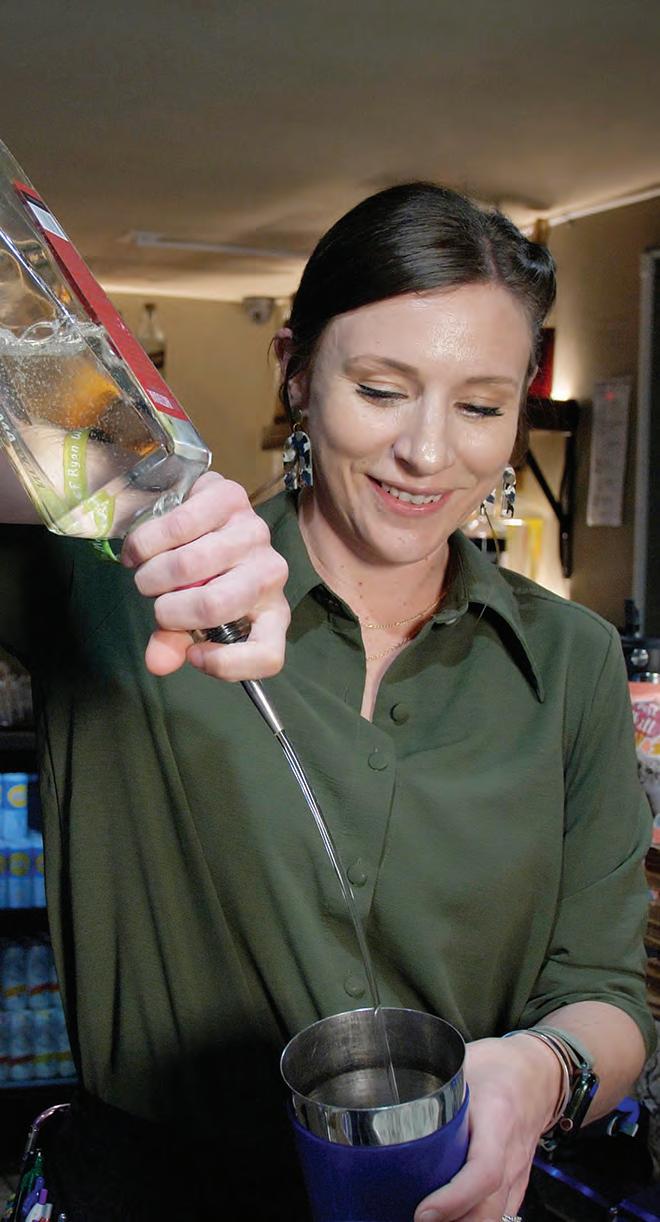
LOCATION: 19920 1st Street in Hilmar, CA
HOURS: Tues-Sat 11 am to 9 pm

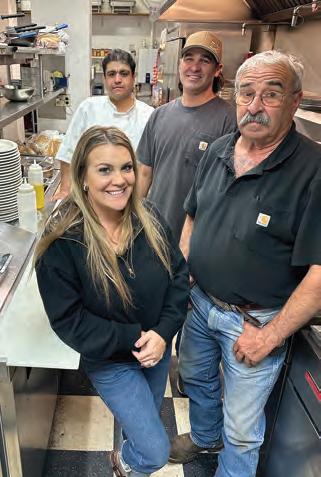

 IBy TERESA HAMMOND
IBy TERESA HAMMOND

t’s a building which is well known throughout the 209, as well as among families living the Western lifestyle. Ranchers, rodeo cowboys, as well as tourists passing through the city of Oakdale know it as H-B Saloon.
However, it’s what’s served from the kitchen to the booths surrounding the bar, as well as in the two rooms behind it which may come as a surprise to visitors.
Sharing the building of 401 E. F St., Oakdale, Bachi’s Family Dining offers qual-
ity food at a reasonable price.
Owned by “Bachi” himself, Mike Bacigalupi, the third-generation owner shared the history of the building and the business is just as much as draw, as is the food.
Starting in the bar business, Bachi’s grandfather David Bacigalupi opened “The Club” on the west side of Oakdale in 1939.
“They moved here the year I was born,” Bachi said of the current location, which has been home to the saloon since 1952. “He had a partner named Frank Hendrick
and they were partners until ’58. When they parted ways the name was already established, so he just left it H-B (Hendrick and Bacigalupi).”
It was a move that would not only prove to be beneficial to the family business, but to travelers as well. According to Bachi the location sees its fair share of regulars by way of vacation home owners stopping by on their way up the hill, as well as tourists stopping in to check out the old saloon.
Through the years the restaurant portion of the building was leased to a variety of other proprietors. In 1997, Bachi decided to make it part of the family business.
“It started as family style,” daughterin-law Jackie Bacigalupi shared of the restaurant.
“It was like a Basque restaurant for 10 to 11 years,” Bachi added, displaying an old wine bottle with a menu printed on the label.
“What we used to do was we served it with the wine in it. The wine in the bottle was included with your dinner,” he shared.
In 2008 the family made the decision to transition to traditional dining, offering lunch, as well as dinner. Currently lunch is served Monday through Friday from 11 a.m. to 2 p.m. and dinner Wednesday through Saturday from 5 p.m. to 9 p.m. The restaurant and saloon are closed Tuesdays and Sundays.
“As far as our menu it’s pretty standard, but Louie (Chef Louie Flores) gets creative with the specials,” Jackie said of the restaurant’s current chef.
“But they get a bang for their buck,” she continued. “People really like the food and when it comes to drinks too. The food and drinks are reasonable.”
According to the duo, the family operated business maintains great food at
a good price. Among regular favorites are the steak sandwich at lunch time or the prime rib special Friday nights. A meal which Jackie shared comes complete with soup, salad, vegetable or potato, as well as a generous cut of prime rib.
“He’s been a great addition,” Bachi said of Chef Flores. “The veggies he does are as you order. He does not let them sit and get soggy. When you put veggies on a deal, he puts them on your plate right out of the pan. We have steam tables but he won’t use them.”
“Oh yeah … everything is fresh,” Jackie added. “He knows the customers and he’ll come up with his own specials that he likes to do. I think it makes him enjoy it more.”
Now in his 20th year in the restaurant business and coming up on his one-year anniversary of serving up food for the Bachi’s clientele, Flores shared he’s happy where he is and with the freedom he’s been given.
“Sometimes they just come to me randomly,” Flores said of the specials. “Honestly, sometimes I’ll be dreaming and I’ll be thinking about work and I’ll wake up and write ideas down. It just comes to me.”
Upon hearing the praises of the family, Flores becomes humbled. Recognizing the business is truly family, the chef shared he loves the environment, as well as the camaraderie of the family in the kitchen.
“Ironically with the family I’ll watch Hell’s Kitchen, but no,” he shared when asked if he watched cooking shows for inspiration when at home. “I mean, I’ve never even opened a cookbook.
“I don’t try to limit myself to one dish,” he continued, regarding if he had a favorite dish he makes. As far as favorite meal, whatever it is he will enjoy,
he said, if he doesn’t have to cook it.
For the Bachi family, there is no pretense on what is offered at Bachi’s Family Dining. Whether you ask the family, the regulars or those just passing through, the answers seem to be the same: great food and a great price.
“We will always be as fair as possible,” Jackie said of the menu and its pricing.
Now watching a fifth generation running around as his own children once did, Bachi shared he loves that they have been able to maintain not only the family dining, but the family connection.
“One cook, one waitress, one bartender, a true family business,” Jackie said with a laugh, adding that they all jump in, including her husband Bo Bacigalupi and his dad whenever needed in the kitchen.
“The people,” Bachi said with no hesitation on what he enjoys most. “People come up and say ‘Thank you, God that was good.’ That makes it all worth it.”
“Making people happy,” Jackie agreed. “It’s just so great to see so many happy people.
The décor of the brick building is both rustic and historic. With family history deep in rodeo and ranch life, the walls tell a million stories and the clientele eat it up.
“Every picture has a story that’s for sure,” Jackie said of the photos which fill the saloon and carry into the dining area.
As the family now celebrates 85 years of service to the community of Oakdale, they remain humble as well as proud and grateful for the support of so many.
“There’s no problem that can’t be fixed,” Flores said of the pride he takes in his work. “I love it here, it’s nice.” ●
HIGH SCHOOL SENIOR BOYS AND GIRLS ALL-STAR GAMES! THESE GAMES WILL FEATURE THE TOP PLAYERS IN THE AREA.
Event Date Saturday, April 27, 2024

EVENT LOCATION
MODESTO JUNIOR COLLEGE 435 College Ave., Modesto CA 95350
DOORS OPEN AT 3:30 PM
JR. HIGH LOCAL ALL-STARS 4:00 PM | GIRL’S GAME 5:00 PM BOY’S GAME 8:00 PM.
BOYS VS GIRLS 3 POINT SHOOT OUT & SLAM DUNK CONTEST
AVAILABLE AT THE DOOR CASH ONLY
$12 ADULTS • $10 SENIORS (65+)
$8 STUDENT (K-12) • $5 YOUTH PLAYERS (K-8)
THIS YEAR’S GAME INCLUDES AN ADDITIONAL FEATURE: “SENIOR CHEER ALL-STARS”.

SENIOR CHEERLEADERS FROM THE 6 DIFFERENT COUNTIES WILL BE AT THE GAME TO SHOWCASE THEIR ATHLETICISM AND TALENT. THEY WILL CHEER AT BOTH GAMES AND ENTERTAIN WITH AN ALL STAR CHEER PERFORMANCE.

YOUTH MUST WEAR HIS/HER BASKETBALL JERSEY TO GET IN AT THIS PRICE. BROUGHT TO YOU BY: & MODESTO SLAM-N-JAM




Ingredients:
¼ cup white sugar
1 tbsp cinnamon
1 box yellow cake mix
2 (3.5 ounce) boxes of instant pistachio pudding mix (dry) 4 eggs
Instructions:
Preheat oven to 350 degrees F. Grease a bread pan with spray oil or butter. In a small bowl, combine white sugar and cinnamon, mix well. Pour cinnamon sugar into loaf pan and gently shake it all around coating the bottom and sides of pan. In a medium bowl, combine cake mix, pistachio pudding mix (dry), eggs, oil, water and sour cream. Batter will be thick, pour the batter into the loaf pan, and spread smoothly on top. Bake for 45-55 minutes or until a toothpick inserted into the middle of the bread comes out clean.

Roasted Diced Almonds*
Let bread rest for 5 minutes before removing from pans and allowing to fully cool on a wire rack. Once cake is fully cooled, make the icing. In a small bowl with a hand whisk, combine vanilla extract, almond extract, and milk. Mix well. Add powdered sugar ¼ cup at a time, mixing well after each addition. After icing is mixed, pour over bread. Top immediately with chopped pistachios and almonds.
Enjoy!



SERVINGS
INGREDIENTS
4 portions boneless salmon
4 tablespoons Asian-style barbecue sauce
2 Envy Apples, cored and sliced into matchsticks or julienned
1 cup sliced or shredded red cabbage
1 cup sliced or shredded white cabbage
1 celery stick, finely sliced
1/2 red onion, finely sliced
1/4 cup mayonnaise
1 tablespoon chopped fresh herbs such as dill, parsley or cilantro
1 lime, juice and zest only
1 tablespoon toasted white sesame seeds, plus additional for garnish
1 teaspoon black sesame seeds, plus additional for garnish
DIRECTIONS
Preheat oven to 375 F using grill or broil setting and line baking tray with cooking paper.
Arrange salmon portions on paper and spread barbecue sauce over each portion.
Bake 5-8 minutes, depending on thickness and size, or until just cooked in center and caramelized on top.
In bowl, combine sliced apple sticks, cabbage, celery and red onion slices; toss lightly.
In separate bowl, whisk mayonnaise, herbs, lime juice and lime zest.
Fold dressing and sesame seeds into slaw and toss together.
Divide apple slaw between serving plates and top with glazed salmon. Sprinkle with extra sesame seeds.

















naturalpathwellness.co






A2018 survey by the Alliance of Science revealed that more than 48 percent of Americans have no idea where their food comes from. Fortunately, those who live near or are visiting Livingston can pick their food right off the stems thanks to Riverdance Farms.
Riverdance Farms is approximately 87 acres large and sits at 12230 Livingston Cressey Rd. right off of the Merced River near McConnell State Park. Owners Cindy Lashbrook and Bill Thompson first moved onto the property in 1996. In two years, the couple transitioned the property entirely into organic land. And beginning in 2004, they began welcoming visitors from far and wide to take advantage of the scenery and their crops for a bi-annual festival and seasonal “U-Pick” events. Individuals are also invited to come over and camp or fish in the bass-rich Merced River, on occasion.
Their annual Spring Festival is slated for Memorial Day Weekend this year, from May 25-27. There folks will be treated to live music, activities for the kiddos, a maker’s market and have the opportunity to pick produce. And there are lots of them.
The couple’s mission is simple — to share good, healthy food and experiences with the public while promoting sustainability.
“I like sharing. When people visit, they support us in keeping it this way…. It’s beautiful land,” Lashbrook said.
The couple and their small but mighty staff of three to five plant things like cherries, blueberries, blackberries, elderberries, tomatoes, pomegranates, plums, persimmons, walnuts, almonds, pecans, honey, lavender and more. They are all grown and sold during their respective seasons, and of course,
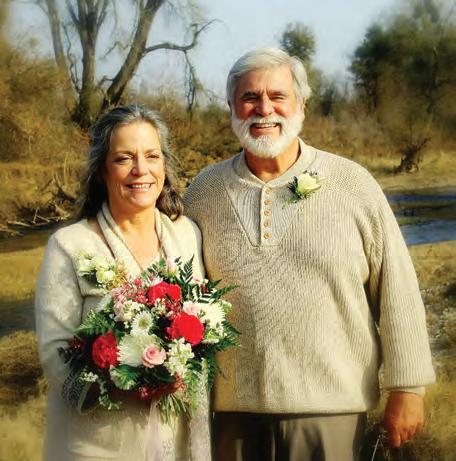
it’s all organic.
Riverdance Farms fertilizes with compost and legume covers crops, seaweed, fish extracts and mined natural minerals. They also work to recycle their prunings and food waste into compost or mulch for the farm. Pest management strategies include the release of beneficial insects, planting hedgerows and cover crops that provide food and shelter to bees, other pollinizers and insectivorous birds.Several nesting boxes
for Barn Owls, bats, American Kestrels and wood ducks have also been built, as each animal helps fend off invasive species.’
The U-Pick season usually starts around the same time as the Spring Festival in May. The same goes for the camping and fishing seasons. For those not wanting to work out a sweat and walk the massive property and choose their produce, there is also a general market for people to shop from.
And as Lashbrook said,




not only are people getting some of the healthiest food grown in the Central Valley and experiencing wildlife in unique ways, but they are supporting the family and their ability to host their festivals and care for the land.
At the festivals, the family hosts hayrides, arts and crafts sessions, lessons on how to identify animal footprints and holds corn grinding classes for the littles, as well as hikes and other activities. Live music is played by local musicians, while food trucks drive onto the property, both selling their snacks and teaching guests how they grew or

obtained their food.
According to the couple, at their peak prior to the COVID-19 pandemic in the spring of 2020, they averaged 800 to 1,200 visitors. Visitors hail from the Bay Area, Southern California and even from out of state. While numbers remain large, they are on a mission to spread the word even more to further entertain and educate folks about wildlife and organic growing.
Aside from the festival, Riverdance Farms opens their gates to the property to local school children, whether they are groups from local elementary

schools, homeschooled children or even young adults attending local colleges looking to learn more and study organic and sustainable practices.
With such a small staff, the family encourages folks interested in visiting the property during the spring and summer to call or text Lashbrook at (209) 761-0081. Prices to camp, fish and attend the Spring and Fall Festivals vary. Those interested are encouraged to visit RiverdanceFarms.com and follow the farm on social media channels Facebook at @Riverdance Farms and Instagram at @RiverdanceFarms_. ●
Just a few miles south of Oakdale, along Albers Road, turn off at VanderHelm Farms and you’ll be able to pick some fresh, flavorful fruits. The family-friendly operation is at 1678 Albers Road and features multiple varieties of berries and tree fruits, along with a handful of vegetables.
The produce comes in throughout the late spring and on in to the summer, said Ron VanderHelm, who runs the farm.
“We sell what we grow,” he said. His wife, Sarah, oversees the farm store, where they do have some prepicked fruit for sale during the season and where purchases – by the bucket –are tallied up.
The land was originally a dairy that his father and mother purchased and his dad ran until the late 1990s. After his father’s passing, his mom leased out the dairy for about 10 years. Then, the family took the land back over and started a small U-Pick blueberry operation with a few acres of blueberries in 2009.
Mom Corrie VanderHelm-Davis continues to help out and also is a wellknown artist.
“The U-Pick is 20 acres,” VanderHelm said of how the farm has expanded since its small start in 2009; nine acres now are devoted solely to blueberries. Aside from blueberries, they also now have U-Pick strawberries, cherries, peaches, apricots, nectarines, apriums, pluots, nectaplums, and more. The strawberries are the first crop to be ready for picking, followed by the
VanderHelm said the busiest day is either Memorial Day or the Saturday before the holiday, and July 4 is busy as well.
blueberries, and other fruits ripen as the weather warms up.
“Strawberries are ready in April for sure, sometimes in March,” VanderHelm explained. “The blueberries are ready, usually the beginning of May.”
They typically open for the U-pick operation the first of May and are open Monday through Saturday, 8 a.m. to 3 p.m.
Hours may vary; information can be found on the VanderHelm Farms website, www.vanderhelmfarms.com.
The farm is not open on Sundays.
VanderHelm said the busiest day is either Memorial Day or the Saturday before the holiday, and July 4 is busy as well. He does have some college students that assist at the farm store during the busiest times and his wife oversees that portion of the business. Their children also help out in the store. The season usually runs through the beginning of August.
The vegetables the farm offers include tomatoes, zucchini and some different
types of cucumbers.
VanderHelm, who worked for years as a mechanic, also spent about 10 years doing both jobs, before deciding to devote all his time to the farm. He stays busy pruning the trees, keeping them short so the fruit is easy to reach, as well as keeping the sprinkler system operating efficiently and maintaining the existing fruit trees. He has also added some more trees in the last couple of seasons.
And as far as the decision to be a fulltime farmer?
“I was done being a mechanic,” he said.
Now, he enjoys working on the farm and watching families come to spend some quality time together. There are a few picnic tables, some playground equipment, and a place to relax after picking the fruit.
“Morning is the best time to pick,” he said, as that is when the fruit is at its sweetest.
People coming in to VanderHelm Farms get a bucket and pick whatever fruit they want – all is within easy reach – and the purchase price is by the pound, with prices varying by the fruit and subject to change during the season.
“VanderHelm said many of those enjoying the U-Pick experience have their favorites and know when a specific type of blueberry – there are some 15 varieties available – cherry or tree fruit likely will be ready and ripe for the picking.
“Most people think it’s fun,” he said. “They keep coming back.” ●

This sign points the way to just a few of the fruits available at the U-Pick operation of VanderHelm Farms, south of Oakdale along Alberts Road.
The peach crop is usually ripe for the picking in early May, offered at VanderHelm Farms just a few miles south of Oakdale.
The strawberries are the first crop to ripen at VanderHelm Farms, and Corrie VanderHelm-Davis was there to get some of the first of the season.




Ron VanderHelm checks on the blooms here; a wide variety of fruits are starting to come in to season at the U-Pick operation owned by the VanderHelm family.

With good preparation and proper care, most berry species can be grown in the Central Valley area, including blackberries, raspberries and blueberries. Cane berries are very manageable if they are trellised and pruned correctly, and if their roots are contained when necessary, such as with red raspberries.
Many Central Valley residents don’t realize that the blueberries (Vaccinium corymbosum) can be successfully grown here. The varieties grown here are the southern highbush types, as northern highbush varieties do not tolerate our hot summers and low winter chilling. All varieties are self-pollinating but fruit set will increase and berries will be larger if two varieties are planted together. Blueberries are deciduous shrubs that grow to 6 feet or taller.
A UC Master Gardener variety trial in Santa Clara found that the following varieties grew the best, produced the biggest crops, and had excellent flavor: ‘Reveille’, ‘Misty’, ‘Sunshine Blue’, ‘Bluecrop’, and ‘O’Neal’. Other species that may also work well include ‘Blue Ray’, ‘Cape Fear’, ‘North Blue’, ‘Ozark Blue’, and ‘Sharp Blue’. Test varieties in small areas before planting large blocks.
Several berry types, both thorny and thornless, are often classified as blackberries and are sometimes called dewberries. The main types are western trailing types (Rubus ursinus) and erect and semi-erect cultivars (no trellis


required), which are being developed mainly for cold climates. Most trailing varieties root at the tips of shoots if they come in contact with the soil.
One of the oldest and most popular varieties of blackberry is ‘Ollalie’, which is actually a cross between blackberry, loganberry, and youngberry. It is large and glossy black at maturity and is slightly longer and more slender than the boysenberry. ‘Thornless Black Satin’ has a heavy crop of large, elongated dark berries and
are good for fresh eating or cooking. Another good variety is ‘Black Butte’. ‘Marion’ berry is widely grown in the Pacific Northwest; it is very spiny and is used mostly for canning, freezing, pies, and jam. ‘Loganberry’ is a cross between wild blackberry and raspberry and is available as thorny or thornless. It ripens early and has large, elongated, dusky red berries that are juicy and acidic, and it can be used for fresh eating, frozen, or preserves. ‘Tayberry’ originated in Scotland and is a cross between blackberry and raspberry. It has thorny canes that bear large, narrow

reddish black fruit with a delicious tart flavor. Boysenberries. The boysenberry, which originated in California, is reddishblack and very large at maturity. Its aroma and sweet-tart flavor are suggestive of raspberries. The vines are thorny and vigorous. The nectarberry and thornless youngberry are very similar, but the youngberry is almost seedless.
Raspberries (Rubus idaeus) are largely grown in the relatively cool, marine climate of the Pacific Northwest. In the Central Valley area, most varieties grow best with some afternoon shade, however, ‘Oregon 1030’ and ‘Bababerry’ prefer full sun. Red raspberries
EVERBEARING OR FALLBEARING VARIETIES PRODUCE FLOWERS AND THEN FRUIT ON THE MATURE TIPS OF CURRENT SEASON’S GROWTH

have invasive roots and will spread unless contained by borders, or unless unwanted shoots are hoed in the spring. Three types of raspberries are available: summer bearing, everbearing, and black. Summer bearing varieties, like blackberries, produce new canes from the ground at the same time that they bear fruit on year’s canes. Everbearing or fall-bearing varieties produce flowers and then fruit on the mature tips of current season’s growth, starting in mid to late summer and continuing through the fall. If not pruned, they would then overwinter and produce a second crop on the lower half of the canes the following summer. Black raspberries have dark fruit that are produced on shrubs, so they need no trellis.

Berries, like most woody plants, will grow on most soil types, provided that the soil is porous and well drained. However, raspberries produce best on sandy loam soil. All soils benefit by the thorough incorporation of well decomposed organic matter. The best organic amendment is compost that has undergone a thorough aerobic decomposition process. If undecomposed material is used, such as manure or leaves, do not plant for at least one or two months before planting to allow it to break down. Any organic amendment should be thoroughly incorporated into the soil, since buried pockets of organic matter may become toxic to roots by not decomposing properly.
Most berries are shallow rooted, and the roots occupy a space about 3 or 4 feet wide. Therefore, the soil should be dug this wide and at least a foot deep; two feet would be better if drainage is poor. If hardpan is present in the top 2 feet of soil, it must be broken up or else roots will not grow and water will not drain properly. Alternatively, use raised beds or mounds to provide adequate soil for
BLUEBERRY PLANTS ARE USUALLY POTTED AND ARE PLANTED ANYTIME, BUT ARE MOST AVAILABLE IN WINTER AND SPRING.
root growth.
Like most woody plants, berries grow best in a soil with a pH of about 6 to 7.5. However, blueberries require a much more acidic soil – about 5.0 to 5.5. To acidify the soil, incorporate soil sulfur (not dusting sulfur) in the top 8 in. at a rate of about 3 to 7 lbs. per 100 square feet. The amount to use depends on soil texture (use higher rate in clay soils, lower rate in sandy soils),
calcium carbonate (lime) content (use higher rate where soil analysis shows high levels), and existing pH. Rototill the sulfur and compost in a strip about 3 or 4 ft. wide in the row in the top 6 in. of soil. Test the soil at planting and every year with a kit available at local nurseries to be sure it remains acidic. Fertilize with an acidic fertilizer, such as ammonium sulfate, and/or side dress or lightly incorporate additional sulfur later.
Cane berries are often planted during the dormant season (mainly December and January), but potted vines can also be planted in spring or summer. All berries should be planted on a small mound or berm if the soil is poorly drained. Bare root blackberries should be set at the same depth they were growing before transplanting, whereas raspberries should be set about an inch lower. Roots should be spread as much as possible and the soil firmed well around them. If the soil is dry, irrigate after planting, but if the soil is wet, no irrigation is necessary. After planting, cover the soil with plenty of mulch, such as wood chips.
Blueberry plants are usually potted and are planted anytime, but are most available in winter and spring. If the plant is older and root-bound, the outer roots should be loosened or pulled away before planting. Plants should be set at the same height as the existing soil level, or slightly above if settling is expected.
In-row spacing for the various berries is as follows: blueberry – 3 ft. (hedge) or 4 to 5 ft. (shrubs); blackberry – 3½ to 4 ft.; raspberry –2½ to 3 ft. Rows should be 8 to 10 ft. apart.
Blackberries, boysenberries, and red raspberries require a trellis on which to tie or wrap the canes. End posts should be strong (4 to 6 in.), and the posts in between (if necessary) can be 2- by 2-in. grape stakes, spaced 20 ft. apart. Strong galvanized wire (No. 10 or 12) should be used for durability.
— Courtesy of the UC Cooperative Extension. For more information, visit: ucanr.edu/ sites/stancountymg ●










































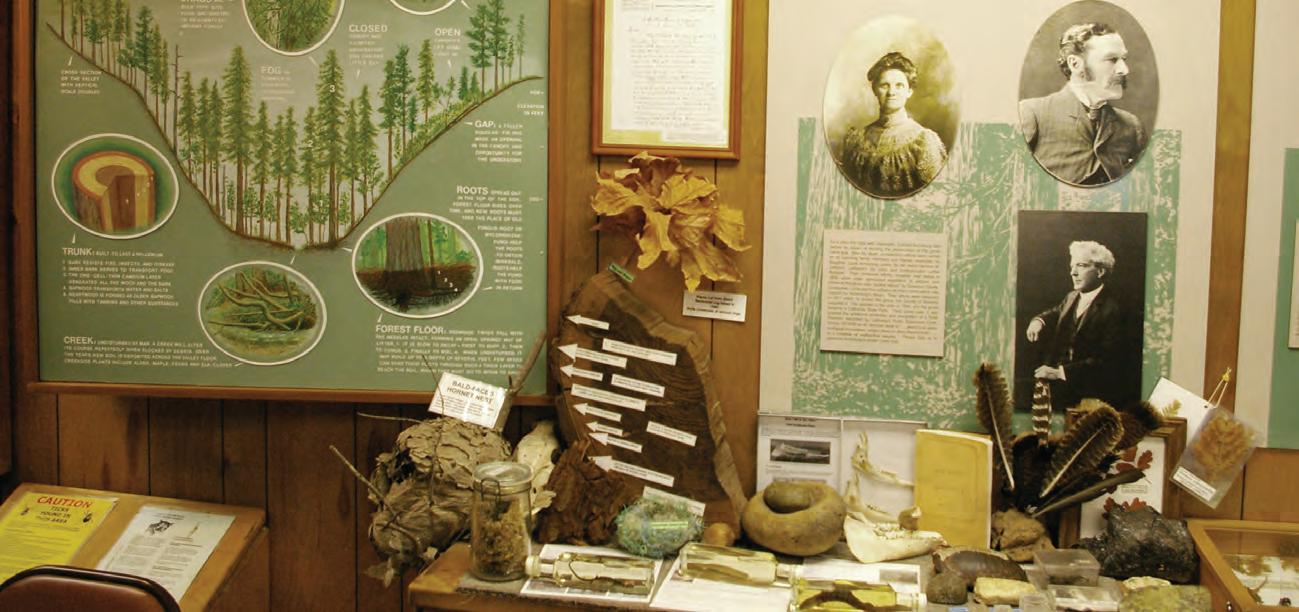
Meandering up the northern coast of California are several pockets of old growth redwoods, relics from a time when the mountains were cloaked in these massive trees. They lay undiscovered until later in the 1800s when logging devoured much of our state’s forests. At the same time, people were beginning to recognize the importance of land preservation and Armstrong Redwoods State Natural Reserve, tucked into a small valley north of Guerneville, is the story of a lumberman’s vision.
Silent Sentinels
The coast redwood, the tallest living thing on our planet – grow-
Encompassing 805 acres, and now nestled against the Austin Creek State Recreation area, ARS was lucky to be spared the logger’s axe.
ing to over 300 feet and living as long as 2000 years – thrives in moist climates, seeking rain and fog for irrigation.
California’s coast range makes the perfect habitat. Water is plentiful, a creek ripples towards the distant river, and black oaks provide a source of acorns, which made the Armstrong grove a popular retreat for Native Americans for centuries.
Encompassing 805 acres, and now nestled against the Austin Creek State Recreation area, ARS was lucky to be spared the logger’s axe. Civil war veteran and businessman Colonel James Boydston

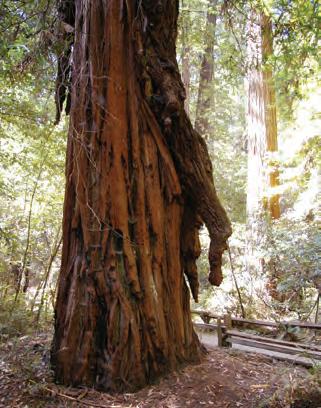

Armstrong purchased 440 acres of the pristine area. Himself a lumberman operating mills in nearby Guerneville during the 1870s lumber boom, he deeded his property to his daughter Kate, with hopes of it one day becoming a nature reserve and arboretum. They began to seek ways to permanently preserve his cherished grove of redwoods. It would not be until 1917, after the Colonel and Kate’s death, and due to the efforts of Kate’s surviving sister, Lizzie Armstrong Jones, that the city of Sonoma agreed to purchase the property for $80,000.
Sonoma County would operate the park until 1934, when the State took financial ownership, and in 1936, the Grove was opened to the public as Armstrong Redwoods State Park. It took considerable vision, when you realize this was during the heart of the Great Depression, for the State to be willing to invest in the future. In 1964, as understanding of the importance of preserving old growth forests increased, the ARS became a State Natural Reserve.


ARS invites visitors to step out of their busy lives and reconnect with nature. Soaring redwoods gaze down from high above the other trees, their full dark green canopies murmuring in the breeze. Patches of pale purple wild sorrel have returned to the valley floor, carefully protected through habitat restoration. Surprisingly, except for periodic bird squawks and an occasional squirrel chitter, there is scant wildlife; the well-shaded floor prevents the growth of plants the animals can eat.
The park includes a must-see visitor’s center that provides a good history, as well as informative docents who can answer any questions. With self-guided nature trails ranging from easy to strenuous, the park offers an ADA accessible 1.5-mile Pioneer Nature Trail loop on the valley floor, as well as routes up the hillslopes with as much as a 1500 foot climb. There are also picnic facilities, although there is no camping inside the park.
The Pioneer Nature trail escorts you past several named trees including Parson Jones (310 feet) and Armstrong (1410
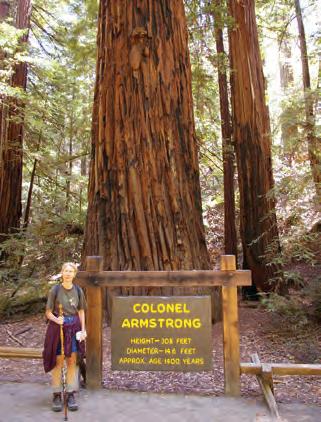
years old). Watch for the curious Icicle Tree, where the bark burls appears to be trickling away from the tree in long “icicles.” There are comfortable wooden benches for rest and contemplation of the ancient sun-dappled trees. Pause, for there is a something soothing in listening to the ancient silence.
Do visit the Redwood Forest Amphitheatre, a short side trail off the loop, which still features regular concerts and dates from the early 1930s. Program information is available at the Visitors Center. The stage is raised earth and stone, and the wooden benches fan outwards beneath the great trees. Let your inner thespian out with an impromptu performance, and you’ll be surprised at the area’s acoustics!
The park is a lovely drive from Santa Rosa through wine country and into the mountains. The fee to enter the park or to park in the main parking lot at the park entrance $10.00 per vehicle. The fees are due whether the kiosk is staffed or not. With an annual average of 55 inches of rain – keep an eye open for the yellow banana slugs which live such moist climate – it’s wise to be prepared for possible weather; check the forecast before you start your hike. To learn more, and to download a trail brochure, visit bit.ly/ ArmstrongReds. ●


My turn to lead on Yosemite’s Washington Column arrived about halfway up the 1,100-foot rock face. The climb’s sixth pitch was a suitable choice because it’s the easiest segment of a route that stretched my modest abilities. After examining the rock features, I sorted through my rack of gear and picked out a metal stopper that I wedged into the granite crack before me. Next I attached a carabiner and atriers (ladder-like slings) so I could stand on the stopper, reach above, place more gear and climb higher. Repeating this process a few dozen times would take me to the next belay point where I would anchor myself and bring up my partner.
But things didn’t work out quite that way. The instant I stepped into the atriers, my first gear placement ripped out of the crack with a loud “pop” and sent me flying. More on that later, but first let me introduce the team. The senior partner of our expedition was Steve, a friend and climbing expert. In contrast, I’m a recreational climber of moderate skill who enjoys scaling granite when time permits.

Matt
retrieves gear from a section of the climb.
We tried to avoid the brunt of the summer heat but caught a triple-digit hot spell anyway that required a large and heavy water supply. So we had to make two trips each between the Ahwahnee parking lot and the base of the column, hauling gear, rope, sleeping bags, food and about five gallons of water to sustain us for three days.
I’VE DONE MANY OF THE SHORTER, EASIER CLASSICS AND ALWAYS WANTED TO GET A TASTE OF BIG WALL CLIMBING.
Steve has done just about every Yosemite climb there is, from the well-known “big wall” routes on El Capitan and Half Dome to dozens of others in Tuolumne Meadows that he established himself. I’ve done many of the shorter, easier classics and always wanted to get a taste of big wall climbing. So when Steve suggested we team up on the South Face of Washington Column, an intermediate route he called a “little big wall,” I gladly roped up with him.
We started climbing at 10 a.m. as the first party of the day, moving fairly smoothly up the first three pitches despite oppressive heat that made sun-exposed granite hard to touch. One difference between our task and simpler climbs I’d done before was the necessity to haul two large bags weighing together at least 100 pounds, half of it water. But Steve handled most of that like the expert he is while I focused on keeping up and keeping hydrated.
About 350 feet up, we arrived at the so-called Dinner Ledge, which oversees the east end of Yosemite Valley. We planned to overnight here on the way up and again on our way down.
But with several hours left in the day, Steve thought we should get a head start on the next pitch which included the formidable Kor Roof, the crux of the climb. I belayed him as he skillfully navigated the overhanging slope and built an anchor at the next belay station. My turn. Ascending the rope with climbing tools called jumars was harder than it looked, especially where the roof juts out, but I managed with some persistence and timely coaching from Steve. Around dusk, we rappelled back to our ledge for dinner at one of the greatest camping spots anywhere.
Rising at dawn the next day, we ate a quick breakfast and started our summit push. Step one was ascending our fixed rope to our highest point of the previous day. This workout got my blood pumping and I could already tell we were in for another scorching day. Step two was our first new
pitch of the day that traversed to the left. Climbing horizontally instead of vertically requires a few tricky moves; Steve cruised as usual and I managed to follow him.
Then Steve suggested I lead the sixth pitch, I geared up to do it and placed my first piece so poorly that it blew out the instant I stepped on it. Because I was still tied into our anchor, I fell only about three feet, though swinging 500 feet above Yosemite Valley made my heart pound. But there’s only one way to improve, so I pulled myself together, tried to forget the setback and started up the pitch again.
The crack offered straightforward climbing but the full pitch was a long one, taking every bit of our 60-meter rope to finish. Around halfway up, I nearly ran out of gear and Steve sent up another supply of stoppers and camming devices on our second rope. Even so, I had to recycle gear near the end just to reach the anchor. Aid climbing, which involves using gear to hold one’s weight, takes longer than free climbing, using gear just to protect against falls. This is especially true for novices, and my single lead pitch took two and a half hours. My throat was painfully dry at the end, and while Steve followed, I hurried to pull up our haul bag full of much-needed water.
The last four pitches that followed were less dramatic yet still rewarding. From the summit, we got a terrific view of Half Dome, which looked close enough to touch. A few hours of rappelling took us back to Dinner Ledge. On the way, the heat kept beating down on us until we finally drank the last of our water. But thankfully, we discovered a gallon jug left behind by other climbers, enough to last us another night.
So we spent a second evening under the stars, enjoying the view, a hot dinner and a few beers Steve thoughtfully packed along. I felt pretty good about the climb and the pitch I had led on it.
Then Steve called his wife to check in; even big wall climbers are electroni-
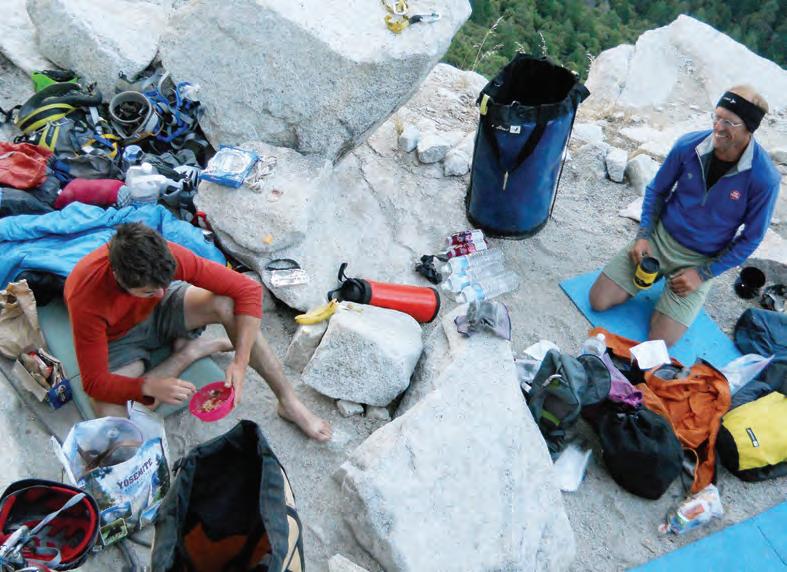
TWO AND A HALF HOURS OF AID CLIMBING, A LAUGH, AND A GALLON JUG LEFT BEHIND.
cally tethered to the world these days. We found out that our friends Hans Florine and Alex Honnold had broken the speed record on The Nose of El Capitan that day, scaling 2,900 feet in an unthinkable two hours and 23 minutes.
In other words, they had climbed 31 pitches faster than it took me to lead one! We got a laugh from that and called to congratulate them. The absurd contrast reminded me that there will always be mountain-sized room for improvement for those who would test themselves in outdoor places like Yosemite. ●
 Dinner Ledge provides a spacious (by climbing standards) refuge for a night on the rock.
Dinner Ledge provides a spacious (by climbing standards) refuge for a night on the rock.

Bordona’s in Oakdale has premiered a state-of-the-art showroom that was designed in collaboration with award-winning interior designer Wendy Glaister created in partnership with SubZero Wolf.
Bordona’s is a family-owned business that spans three generations and their new designer showroom highlights their mother’s legacy and time-honored cooking classes. Some
of the stand-out offerings include SubZero refrigeration including specialty Wine, Beverage, Panel-Ready, Tower, and Built-In refrigeration. The Wolf appliances in Bordona’s include induction and gas cooking, a steam oven, a built-in Wolf Espresso Machine with a warming drawer for coffee cups, and a Wolf vacuum sealer that assists in sous vide cooking for meats, poultry, and fish dishes.
“We are so excited to debut our new live demo kitchen showroom created in partnership with SubZero Wolf. When we first began the design phase one of our biggest goals was to help better service Central Valley California with cutting-edge, innovative, and luxury kitchen designs,”

said Ron Bordona, Bordona’s showroom co-owner.
The remodeled space features a SubZero Wolf Cove live demo kitchen, which is dedicated to Ron’s 86-year-old mother Phyllis Bordona. She was known as the microwave lady and for her hosting microwave cooking demonstrations at the store starting in 1971 and extended for decades. Phyllis’ claim to fame was preparing a Thanksgiving meal in a microwave including moist turkey prepared in less than two hours.
Bordona’s SubZero Wolf Cove live demo kitchen features two unique designs on display that showcase contemporary traditional kitchen lines offered by the brand. Glaister, founder of Wendy Glaister Interiors, worked with the Bordona’s team to create the two kitchen styles so that the showroom may offer special events, partnering with high-profile chefs’ to demonstrate the new alluring kitchen designs and features.
“Working with designer Wendy Glaister, and through our partnership with SubZero Wolf we are able to bring a live demo kitchen to our community,” Bordona said. “Wendy made the design process seamless and together we were able to create a stunning and modern showroom that allows our customers to experience the live demos and amazing chefs while we honor the legacy our family-owned business has created.”
Bordona’s new showroom also offers an exclusive introduction to


the Zip Water appliance - which offers the HydroTap that dispenses filtered cold, sparkling, and boiling water, all in one convenient faucet.
“I couldn’t be more thrilled with the way Bordona’s new showroom turned out and to have Zip Water on display in our community,” said Glaister, a brand ambassador for Zip Water. “I am extremely proud of how everyone on the team worked to accomplish this beautiful project. It is beyond even what I imagined. I can’t wait to bring my design clients and shop from the endless


options Bordona’s has on display.”
Community partners and installers that worked with the Bordona’s team on the new showroom include Woodworks by David: cabinets; Main Electric: wiring and lighting installation; Carrie Arnold: lighting design; Jason Parris: tile installation; Purestone: countertop fabrication; Cosentino Dekton: countertop material; Pacific Shores Stone: quartzite material; and Artistic Tile, tile backsplash. ●

Outsidepride.com
There’s a sustainable, drought-tolerant alternative to high-maintenance, water-guzzling grass that also reduces the environmental footprint, for those looking to renovate their yards.
“Clover lawns” went viral on social media last fall and became the most searched home improvement trend on Google in 2023. If you search #cloverlawns on Tik Tok, viewed more than 150 million times, you’ll be bombarded with photos and videos of fluffy, lush, green, gorgeous lawns grown with Miniclover seeds.
“’Miniclover’ (Trifolium repens) is about 1/3-1/2 the size of white Dutch clover, only grows 4-6 inches and produces a thick, carpet-like look that blends well with turf,” said Troy Hake, president and owner of Outsidepride. com, offering drought-tolerant grasses, clovers, wildflower seeds and more. “It’s less expensive than grass seed and a natural solution for self-sustaining, lowmaintenance lawns that look beautiful and help eliminate the need for fertiliz-
Clover lawns went viral on social media last fall and became the most searched home improvement trend on Google in 2023.
them more frequent, longer and more severe. Grass lawns, however, are not sustainable; they’re the most maintenance-intense part of yards, requiring regular fertilization, mowing and heavy irrigation to look good. Nationwide, landscape irrigation is estimated at almost 1/3 of all residential water use, totaling nearly 9 billion gallons per day. Plus, gas-powered lawn and gardening equipment release more than 30 million tons of carbon emissions, according to the U.S. Environmental Protection Agency’s National Emissions Inventory.
ers, herbicides, pesticides and weekly mowing. We sold out of it for the past two years, even with a two-fold increase in production. You can’t go wrong with it.”
Wondering why grass gets a bad rap? The truth is climate change is looming and has further altered the natural pattern of droughts, making
In some regions, there’s continuous, strict regulations on watering lawns or bans on the use of drinking water for irrigating grass. As concerns about climate change and water scarcity intensify, some homeowners are looking for landscaping solutions that minimize water usage and reduce environmental impact. A standout in this regard, Miniclover requires significantly less water than traditional grass to thrive. It’s

drought-tolerant and has longer, deeper roots than grass, reaching into the soil for needed moisture, requiring minimal watering, staying greener longer and showing more resiliency during periods of drought or water restrictions.
It takes nitrogen from the air, “fixing” it in the soil and eliminating the need for fertilizer or nitrogen plant food because it does the work for you, keeping grass green and growing while adding natural nitrogen to surrounding soil.
Some homeowners are already tearing up grass and completely replacing it with Miniclover; others are overseeding existing grass, reaping the many benefits of clover while maintaining a lawn-like look without committing to a complete lawn replacement. Both options are more sustainable and environmentally friendly than grass lawns.
With hectic lifestyles the norm, many homeowners want landscaping solutions that require minimal upkeep. While grass lawns require constant mowing, watering and fertilizing, perhaps it’s time to grow something other than traditional turf. Miniclover’s slow
growth habits mean less time behind the mower while its dense growth pattern, evenly dispersed via stolons (stems that grow horizontally along the ground), crowds out weeds and controls erosion.
No need for herbicides; they’ll kill it. Grubs won’t eat it and bugs won’t lay eggs in it. It stands up to compacted soil, plus it’s immune to “dog patches.” It fills in bare spots fast and tolerates wet conditions. Mow as little as you like - the more it’s cut, the smaller the leaf size - or simply let it grow close to the ground, like grass. It blooms only once in summer with small, delicate flowers, which provide bees with nectar or, if preferred, mowing prevents blooming. It withstands foot traffic, making it ideal for pathways and play areas and its tolerance for shade makes it suitable for areas with limited sunlight.
For homeowners looking to reclaim weekends and minimize

time and effort spent on lawn care, Miniclover seems like a dream. It lives up to its hype, offering the winning combination of environmental sustainability, very low maintenance, drought tolerance, aesthetic appeal and cost efficiency that benefits not only homeowners’ properties, but planet Earth as well.
For more drought-tolerant options, visit Outsidepride. com. ●







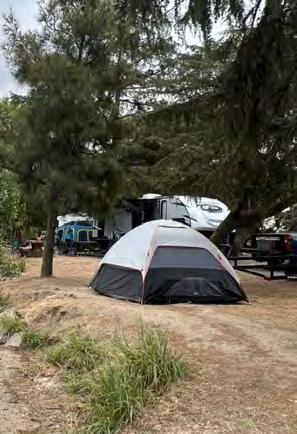





























How’s those 2024 Goals shaping up?
Yes, I know it’s April and May, but with three solid months behind us, I like to reflect and revisit the goals I’ve set for myself.
With this year’s new approach of setting quarterly goals versus year long achievements I had sort of convinced myself that would be easier. I was wrong.
Truth of the matter is, life changes take work, commitment and yes, time.
Looking at 2024 I must admit, I’m thrilled with the outcome of a few items, ahead of the game on a few and still struggling with others.
Falling back into a committed fitness routine and solid health program as I once did continues to be my Achilles heel. Truth be told when this column space was started my routine was rock solid.
What I recognize now is while it may not have been at the hands of a personal trainer, it was at the hands of two small people who occupied the majority of my down time. Squeezing in workouts was set for early morning in my garage or 8 p.m. once they were put to bed.
The “healthy” part honestly came easy, as we want to feed our kids well and give them healthy foods. We were also on a very tight budget which made eating out a treat more than a mainstay.
Now as the mom of two independent young adults, both of these things tend
to pose more challenge than I ever thought they would.
This coupled by the returning to an open planner, no longer filled with treatment days, doctor’s appointments or lab work.
At times, I feel like a broken record on this topic, so for those tired of hearing it; I truly apologize.
That being said, I also feel it is one of the most under talked about life challenges. Not the disease specifically, but rather how life is as a patient once you’re on the other side.
NAVIGATING LIFE’S CHALLENGES WITH GRACE AND SELF-LOVE IN 2024.
Keeping in mind, no two are the same and everyone’s experience different.
When your life has been spent this way however, for an extended period of time, there are certain things you’re not completely prepared for.
I’ve touched on this in prior columns, so rather than be redundant and rehash much of the same, I’ll simply share this; remember grace.
That’s what I seem to be learning the most as we travel the 2024 year.
Four years of a hell, I would never wish on anyone has brought me to a place of excitement for life that’s on
a complete next level. My goals list is quite honestly all over the board. I’d imagine it’s somewhat like a person freed from prison with a host of opportunity before them.
That’s me.
My weight loss journey was a level of success I could never have fathomed 13 years ago. When I use the word “success” it comes from a space of recognizing I not only lost weight but changed my life 180 degrees, maintaining the loss and achieving some really cool stuff - in my 40’s.
Where grace comes in, for those of us who have overcome disease, depression or maybe quiet simply an unexplained rut - our bodies are different.
My medical team is most definitely the best at reminding me of this. Four years post diagnosis I am not only four years older, but my body has been completely broken down at the hands of beating a disease that could’ve killed me.
That’s harsh truth and while I did my very best to maintain my health and strength during the battle, the final year brought that to a halt and that’s okay.
Now we look ahead, we live as fully as we possibly can each and every day. Some days that’s going full tilt at all that life has to offer and others is sitting with a cup of coffee or glass of wine simply taking in the beauties of life. Balance.
So as you reflect, revisit or perhaps redefine what 2024 should look like for you remember grace, not just for others but yourself. We truly must love ourselves if we are to be of any value to the rest of the world. ●

WHEN I USE THE WORD “SUCCESS” IT COMES FROM A SPACE OF RECOGNIZING I NOT ONLY LOST WEIGHT BUT CHANGED MY LIFE 180 DEGREES, MAINTAINING THE LOSS AND ACHIEVING SOME REALLY COOL STUFF - IN MY 40’S.
Katelyn Hasley is passionate about what she does. With knowledge of the body, a former life in body building and a great love of yoga, the owner of The Fix Aerial Arts loves leading students in a gentler way of serving the body.
“It’s like where my heart and soul is,” the Oakdale business owner and instructor said of yoga. “I found yoga at a time in my life where I needed to heal, emotionally and spiritually.”
Her love for yoga that began over 20 years ago, however, proved to be the start of other alternative offerings for serving the body.
The Fix Aerial Arts offers students yoga, Barre and Aerial arts classes. The Aerial arts classes include Hammock, Lyra and Split Silks.
While her first love may be yoga, the instructor shared she also loves teaching aerial.
“I remember when it first came out, I think it was 15 years ago when I saw aerial for the first time and then I saw aerial yoga,” the fitness instructor said.
Admitting she thought it was very cool, as she began to see it more and more, she decided to begin taking classes herself.
“I love it. I fell in love with it for myself and I thought other people would really like it and enjoy it,” she stated.
“We use it to basically do gymnastics in the air,” she explained of the silks and aerial accessories. “It’s a performance art, whereas yoga is basically the opposite of that. You’re not performing. It’s there to serve you. Where aerial acro-
batics is an art that we perform.”
Hasley offers Aerial Acrobatie and Aerial Yoga classes which are each one hour long and offered as courses or bootcamps versus a traditional drop in class.
“It just made more sense all the way around,” she said of offering courses vs. classes. “It’s so important for safety that you’re learning all the basics and that you’re getting the skills in levels.”
Aerial courses are offered for all ages; children and adults. Courses tend to run 16 weeks, which will allow students to go from the basics to completing the skills.

Hasley further shared that Aerial Yoga is silk assisted yoga allowing for a deeper stretch or a deeper variation of a pose.
“The spring floors are the perfect flooring for our aerial classes. It’s amazing,” she said of the location where she offers classes.
“We start with very basic conditioning and we actually start on the floor,” she said of aerial courses. “We start on the floor teaching shapes and teaching hollow body conditioning. So you’re getting into that shape and you’re engaging all your muscles.”
Another great form of “engaging muscles” would be Barre classes which Hasley describes as a ballet inspired Pilates.
“The term Barre is actually ballet and Pilates combined,” she explained.
“Our Barre class I call it Barre Bootcamp because we’re incorporating strength, which I feel is important. I want to make sure our classes are complete.”
The fitness enthusiast noted that Barre offers a type of movement which is necessary and essential, as well as a great complement activity to yoga.
“I’m a lover of all types of movement,” she said, regarding what drew her to Barre. “The conditioning you get from ballet, that’s what we take into the Pilates and into the class.”
Barre Bootcamps offered by the studio owner are typically six weeks and classes are twice weekly.
“If you don’t use it you lose it. Movement is just so good,” she said of Barre and its appeal to women of all ages. “It’s good for your body and good for your mental health.”
Whether it be yoga, aerial or Barre the business owner shared she is most at home sharing her passions and helping clients transform and strengthen their bodies.
“I really love teaching all the classes. I wouldn’t be offering any classes I didn’t love teaching.”
Course offerings and Bootcamps for the varying workout types can be found on thefix.biz.
The Fix is at 628 Delano Drive, Oakdale. ●
























Twenty-eight years ago when the Iyer family purchased a charry farm on the outskirts of Gustine, they did it with the vision that they could cultivate the 20-acres into a successful operation.
One hiccup, however, existed. Those initial cherries were not good. In fact, Managing Partner Lax Iyer described them as “old” and “nasty.”
“But we used them to learn,” Iyer said. And learn they did. From studying climates, soils, growth patterns, packaging and everything else related to cherries, Iyer threw himself into growing the best quality cherry he could.
“We are in the business of satisfying customers with amazing flavor,” Iyer said. “That has been our goal from day one.”
Today, Meena Farms, which has grown to 800 acres of cherry trees, is known across the globe for their flavorful harvest and superior quality. Their orchards became a place where tradition met innovation when they opened a custom packing operation and are currently embarking on Meena Packing, which will see the entire operation from harvest to packing all at one facility, rather than having the cherries shipped to another facility to be packed and then loaded up for shipping, all of which can impact the flavor, explained General Manager Chris Medeiros.
“As soon as you pull that cherry from the tree, its time clock starts,” Medeiros said. “It’s like sand in the hourglass and you only have so much time to get it from your field to the consumer. How you handle the product is extremely important. Cold chain is paramount. So, having something centrally located made
sense for our operation.”
Meena Farms is taking the same dedication to quality and applying it to Meena Packing.
“This will be the most state-of-theart cherry facility probably in North America,” Medeiros said. “Each piece of fruit is picked by hand and each is sorted individually. Then it’s run under high speeds by a camera as it is rotated. There’s dozens of pictures taken of that piece of fruit externally. Internally, we can see if there’s some defect near the pit. We can sort them by size, shape, color, firmness and now there is even technology that will allow us to sort by Brix level, which is the sugar level. It’s put into a box and we can trace back to that box that piece of fruit to the ranch and where it came from. That’s how state-of-the-art we are talking about.”
Export sales make up the bulk of Meena Farms’ business, with their cherries highly sought after across the globe.
“After seven years we are the number one label in many countries,” Medeiros said. “We’re the number one label for
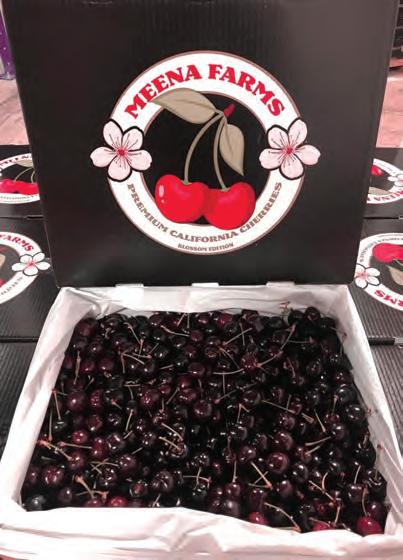
cherries out of California and sometimes are buyers tell us we were the best fruit they bought all year. It goes back to the practices that we use and also the area has a lot to offer in the way of water, soil and climate.”
Meena Farms can also be found in some retail outlets and has plans to offer the cherries on site.
“We’ve come a long way from those first 20 acres of trees,” Iyer said. “It’s just incredible. The journey has been wonderful.” ●




